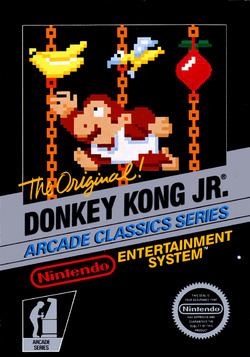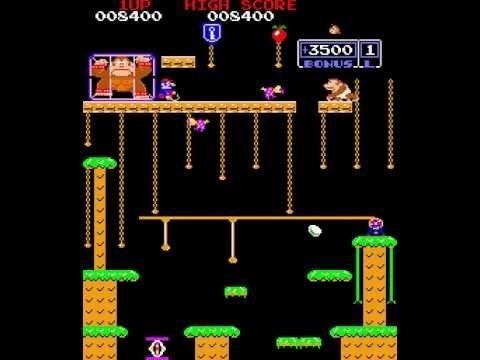9 /10 1 Votes9
Composer(s) Yukio Kaneoka Genre Platform game | 4.5/5 Emuparadise Distributor(s) EU: CBS Toys Initial release date 1982 | |||||||||||||||||||||||||||||||||
 | ||||||||||||||||||||||||||||||||||
Artist(s) Shigeru MiyamotoYoshio Sakamoto Platforms Nintendo Entertainment System, Arcade game Developers Nintendo, Coleco, Atari, Nintendo Research & Development 1 Similar Donkey Kong games, Atari games, Platform games | ||||||||||||||||||||||||||||||||||
Arcade longplay 355 donkey kong jr
Donkey Kong Jr. (ドンキーコングJR., Donkī Kongu Junia) is a 1982 arcade-style platform video game by Nintendo. It first appeared in arcades, and, over the course of the 1980s, was later released for a variety of platforms, most notably the Nintendo Entertainment System. The game's title is written out as Donkey Kong Junior in the North American arcade version and various ports to non-Nintendo systems. Its eponymous star, Donkey Kong Jr., also called simply Junior or abbreviated as DK Jr., is trying to rescue his father Donkey Kong, who has been imprisoned. Donkey Kong's cage is guarded by Mario, in his only appearance as an antagonist in a Nintendo video game. This game is the sequel to the video game Donkey Kong, which featured Mario as the hero and Junior's father as the villain.
Contents
- Arcade longplay 355 donkey kong jr
- The tiniest donkey kong jr arcade ever rare obscure or retro rerez
- Plot
- Gameplay
- Development history
- Ports
- Reception and legacy
- Competitive play
- In other media
- References

The tiniest donkey kong jr arcade ever rare obscure or retro rerez
Plot

Mario, who originally appeared in Donkey Kong, has captured Donkey Kong and placed him in a cage as punishment for kidnapping his girlfriend Pauline. Donkey Kong Jr. must rescue his father from Mario by working his way through a series of four screens. Mario attempts to stop DK Jr. by releasing animals and putting obstacles in his way. When DK Jr. succeeds on the last screen, Donkey Kong is freed and kicks Mario into the distance, leaving him to an unknown fate; the game then begins again at a higher difficulty level.
Gameplay
Like its Donkey Kong predecessor, Donkey Kong Jr. is an arcade-style platform game. There are a total of four stages, each with a unique theme. DK Jr. can run left and right, jump, and grab vines/chains/ropes to climb higher on the screen. He can slide down faster by holding only one vine, or climb faster by holding two. Enemies include "Snapjaws," which resemble bear traps with eyes; bird-like creatures called "Nitpickers," some of which can attack by dropping eggs; and "Sparks" that roam across the wiring in one of Mario's hideouts. DK Jr. can jump over these enemies while on platforms, switch from one vine/chain/rope to another to dodge them, or knock down pieces of fruit that will destroy every enemy they touch before falling off the bottom of the screen.
To pass the first three stages, DK Jr. must reach the key hanging next to his father's cage, whereupon Mario flees while pushing it off the screen. In the fourth stage, DK Jr. must push six keys into locks on the topmost platform to free Donkey Kong. After a brief cutscene, the player is taken back to the first stage at an increased difficulty. A bonus timer runs throughout each stage, and any points remaining on it are added to the player's score upon completion.
DK Jr. loses a life when he touches any enemy or projectile, falls too great a distance, or falls off the bottom of the screen. Additionally, he loses a life if the bonus timer counts down to zero. The game ends when the player loses all of his or her lives.
Like in its predecessor, Donkey Kong Jr. features a kill screen at level 22. Due to the level counter only having one digit, the counter shows numbers 1 to 9 in levels 1 to 9, seven blanks in levels 10 to 16, and the letters A to F in the levels 17-22. The kill screen occurs the same way as in Donkey Kong, where an integer overflow occurs after too big a result is given after a multiplication problem in the computing. The timer counts as if there are 700 points, then kills Donkey Kong Jr. until all lives are taken.
Development history
The game was principally designed by Shigeru Miyamoto and one of his coworkers. Miyamoto also created the graphics for the title along with Yoshio Sakamoto. As with its predecessor, the music for the game was composed by Yukio Kaneoka.
Ports
Like other arcade games of this era, this game was ported to many home systems, including the video game consoles NES, Family Computer Disk System, Atari 2600, Atari 7800, Atari 8-bit computers, ColecoVision, Coleco Adam, Intellivision and BBC Micro. Two Game & Watch versions of the game were also made. One black-and-white version for the New Wide Screen handheld series, and a color version for the Tabletop and Panorama series. The NES version–along with its predecessor Donkey Kong–was re–released in 1988 in an NES compilation titled Donkey Kong Classics. This version was later released on the e-Reader and is available on the Virtual Console for the Wii. The NES version is also a playable game on Animal Crossing, though a special password is needed from an official website which is now no longer available. It was made available for the Nintendo 3DS from the Nintendo eShop, released in Japan on April 18, 2012, in North America on June 14, 2012 and in Europe on August 23, 2012 and was given away free to the Ambassadors users before the full release. A conversion of the Atari 7800 version also appeared on the Commodore 64, released 8 November 2014, coded by Mr. SID, and available for free from CSDB.
Reception and legacy
Donkey Kong Jr. received an award in the category of "1984 Best Videogame Audio-Visual Effects (16K or more ROM)" at the 5th annual Arkie Awards, where the judges described it as "great fun", and noted that the game was successful as a sequel–"extend[ing] the theme and present[ing] a radically different play-action" than its predecessor, Donkey Kong.
Donkey Kong Jr. is regarded as one of the Top 100 Video Games by the Killer List of Videogames. It was selected to be among five arcade games chosen for history's first official video game world championship, which was filmed at Twin Galaxies in Ottumwa, Iowa by ABC-TV's That's Incredible! over the weekend of January 8–9, 1983. The game later spawned a cereal which featured fruit-flavored cereal pieces shaped like bananas and cherries. Donkey Kong Jr. is shown on the box wearing a red shirt with a big yellow J printed on the front.
Competitive play
For more than twenty years, the Donkey Kong Jr. world record had been held by noted gamer Billy Mitchell, who had achieved 957,300 points in 1983. On August 10, 2008, Mitchell's benchmark score was eclipsed by Icarus Hall of Port Angeles, Washington, who scored 1,033,000 points.
On April 24, 2009, Steve Wiebe eclipsed Hall's score, finishing with 1,139,800 points. On September 3, 2009, at 1984 Arcade in Springfield MO, Mark L. Kiehl of Enid, OK surpassed Wiebe's record with a score of 1,147,800. Steve Wiebe has since regained the record with a score of 1,190,400 on his home machine set on Tuesday, February 16, 2010. Billy Mitchell recaptured the world record for Donkey Kong Jr. on the weekend of July 24, 2010 with a score of 1,270,900. Mark Kiehl has since eclipsed the previous world record with a score of 1,307,500. As of November 2016, Kiehl continues to hold the record today with a score of 1,412,200.
In other media
Donkey Kong Jr. is one of the 8 playable characters in Super Mario Kart for the SNES.
Donkey Kong Jr. was also a cartoon on Saturday Supercade (a cartoon series that aired on Saturday mornings from 1983-1985) with the title character voiced by Frank Welker. The plot had Jr. looking for his dad Donkey Kong who is on the run from Mario and Pauline. To look for his dad, Donkey Kong Jr. teams up with a Greaser named Bones (voiced by Bart Braverman).
In an episode of Captain N: The Game Master called "Simon the Ape Man," Simon Belmont got hit on the head a second time while in Kongoland and thought he was Donkey Kong Jr.
In the version of Super Mario Bros. 3 seen in Super Mario All-Stars, as well as the Game Boy Advance version, the king of World 4 was transformed into a monkey with a 'J' on his shirt resembling Donkey Kong Jr.'s shirt.
Donkey Kong Jr. is among the characters in Super Mario Maker that players can transform into by use of mystery mushrooms.
